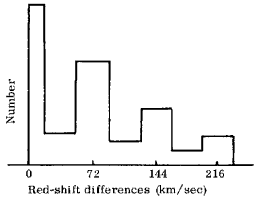 |
Science Frontiers ONLINE No. 41: Sep-Oct 1985 |
|
|
Galaxy Redshifts Come In Clumps
"Red shifts in the light from distant galaxies seem to favor certain values, at intervals corresponding to a spacing of 72 kilometres per second, if the red shifts are interpreted as indicating the recession velocities of the galaxies. According to the latest evidence, this provides a yardstick against which we can measure the absolute motion of the Sun through space. This rather startling indication that the red shifts of galaxies are quantised, rather like the atomic spectral lines by which the red shifts themselves are measured, has a pedigree that goes back more than 10 years. Since 1972, W.G. Tifft, of the University of Arizona, has been producing evidence for the red shift quantisation from analyses of various catalogues of galaxy red shifts and, as his collection of data has mounted, the idea, unpalatable though it seemed at first, has become steadily more respectable. It has not taken the astronomical world by storm, and even Tifft has no definite idea why the red shifts should be grouped like this. But it is no longer possible to dismiss the evidence out of hand."
Actually, Tifft has speculated that galaxy redshifts might represent an intrinsic property of galaxies, which takes on quantized values, like the energy states of an atom!
(Gribbin, John; "Galaxy Red Shifts Come in Clumps," New Scientist, p. 20, June 20, 1985.)
Comment. We have touched before on the possible quantization of macroscopic nature. See: SF#36, "Galactic Shell Game," and SF#32, "Thou Canst Not Stir a Flower/Without Troubling of a Star."
Reference. Redshift quantization is cataloged in AWF8 in our Stars, Galaxies, Cosmos. For a description of this catalog, visit: here.
 | Tifft compared red shifts of physically associated galaxies and found the differences to be integral multiples of 72 km/sec. |